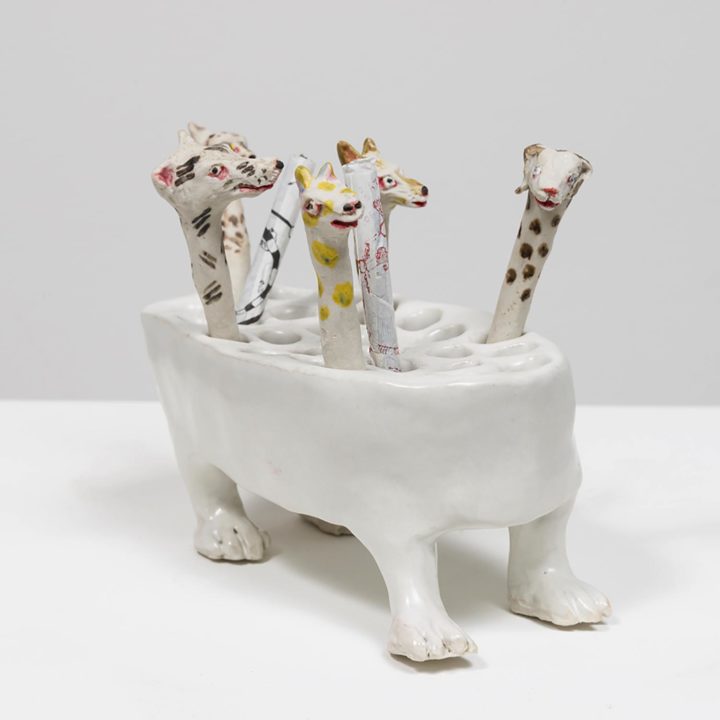The eleventh edition of ART-O-RAMA, originally launched in 2007, took place at the end of August in the suggestive urban space of La Friche la Belle de Mai, previously a tobacco factory, in Marseille, South of France. In recent years, the nontraditional Marseillese art fair has grown considerably, but it always remains devoted to its original format in which a selection of local and international galleries are invited to curate their booths alongside artist projects. The goal is to appear more like an exhibition space than a traditional fair.
Flash Art spoke to director Jérôme Pantalacci and curator Luigi Fassi, together with Vincent Honoré, in charge of this year’s CURATORS TOURS project.
ART-O-RAMA has a more relaxed and intimate dimension compared to other international art fairs. In your opinion, what are ART-O-RAMA’s strengths?
Jérôme Pantalacci: ART-O-RAMA is held late August, in Marseille, which is located between the French Riviera, Camargue and Luberon — three areas where many people (collectors, gallerists, artists) go on vacation. We kick off the season after the summer break. People are relaxed because you can still feel the sweet breeze of holidays in the air.
We also put a lot less economic pressure on gallerists and focus on the artistic proposal. Therefore, gallerists are more relaxed and so are collectors. Everybody is able to take time to meet each other, to discuss and to discover. It is, obviously, also the small number of exhibitors that gives you the possibility to see everything and everyone. As we focus on artist projects and give the gallerists a lot of freedom, the fair doesn’t look like a traditional art fair. Each exhibitor has to design their own booth. We do not have a predefined size or shape. The spaces are mainly open and quite large, which creates visual connections between the different proposals and allows people to circulate even more.
What’s the story behind ART-O-RAMA’s name?
JP: When I was looking for a name, I didn’t want anything that sounded like “Art Marseille.” I wanted a name that contained “art” and which could be used in different languages without denying the link to Marseille. An artist and friend, Olivier Millagou, who is involved in the artistic committee, made a work titled SURF-O-RAMA. I thought that if we replaced “surf” with “art” that could work. So, I asked him for the right to use his idea and he agreed.
How do you envision the future of ART-O-RAMA?
JP: Our aim is not so much about growing bigger. We could easily fill the space with sixty galleries if we wanted to, and make it a profitable business. That is not the core of the project. This year we have twenty-six galleries, six publishers and one nonprofit art space. We will probably have more exhibitors next year, but just enough to amplify a bit the project without losing the spirit of the fair. Our goal is that each exhibitor has enough space to develop their project.
In the future we want to be even more international. Galleries come mainly from Europe and a little bit from the U.S. We want to enhance our Mediterranean connections, and are very keen to develop Southern Europe, Northern Africa and a Middle Eastern perspective — without losing the links with Eastern and Northern Europe, obviously. Marseille is a good point of connection between the three continents. We pay attention to American, Asian and African art scenes as well.
Can you share with us some special news about the 2018 edition? Tell us about some of the programming you have developed for the next edition.
JP: Next year’s edition is taking place from August 31 to September 2, 2018, and will be called “ART-O-RAMA 2018, By the Sea,” as we will change the location of the fair from the industrial and cultural site of La Friche la Belle de Mai to the MJ1 maritime hangar. The MJ1 Hangar is the last shipping warehouse in Marseille. Located in La Joliette waterfront next to the Mucem, this gigantic site has been renovated into a cultural center by the Port of Marseille as part of the general EuroMediterranean project and the European Capital of Culture in 2013. It is a larger venue, and very well located. The fair will be situated between many visual as well as symbolic views: the city on both sides, and in front, the sea horizon, with Marseille’s islands and North Africa beyond them.
Luigi, last year you were invited by ART-O-RAMA to curate the Show Room section. This year you lead the first edition of CURATOR TOURS. What was your expectation for this new role? And how did the galleries react?
Luigi Fassi: Show Room is a series of four solo shows organized by selecting artists who have graduated from art academies in Southern France within the last five years. CURATOR TOURS, initiated by the fair in 2017, offers collectors and other visitors the chance to explore the fair as if it were an exhibition, under the guidance of two curators, me and Vincent Honoré. I have envisioned it as a proper show, titled “Transformative Experience,” one in which you make visitors realize how engaging and transformative a visit to an art fair can be.
During one of your tours you said, “Art can help the fact that you can perceive things not rationally.” Starting from this consideration, would you like to reveal to us three of your favorite artworks that provoked irrational feelings?
LF: Two laser-cut drawings on fabric by Marieta Chirulescu; Vajiko Chachkhiani’s Elephant On Her Way to Vanish, an attempt to translate poems by American poet Edna St.Vincent Millay into sculpture; and Utopias are for Birds by Alvaro Urbano, birdhouses built after unrealized twentieth-century utopian architectural projects.

